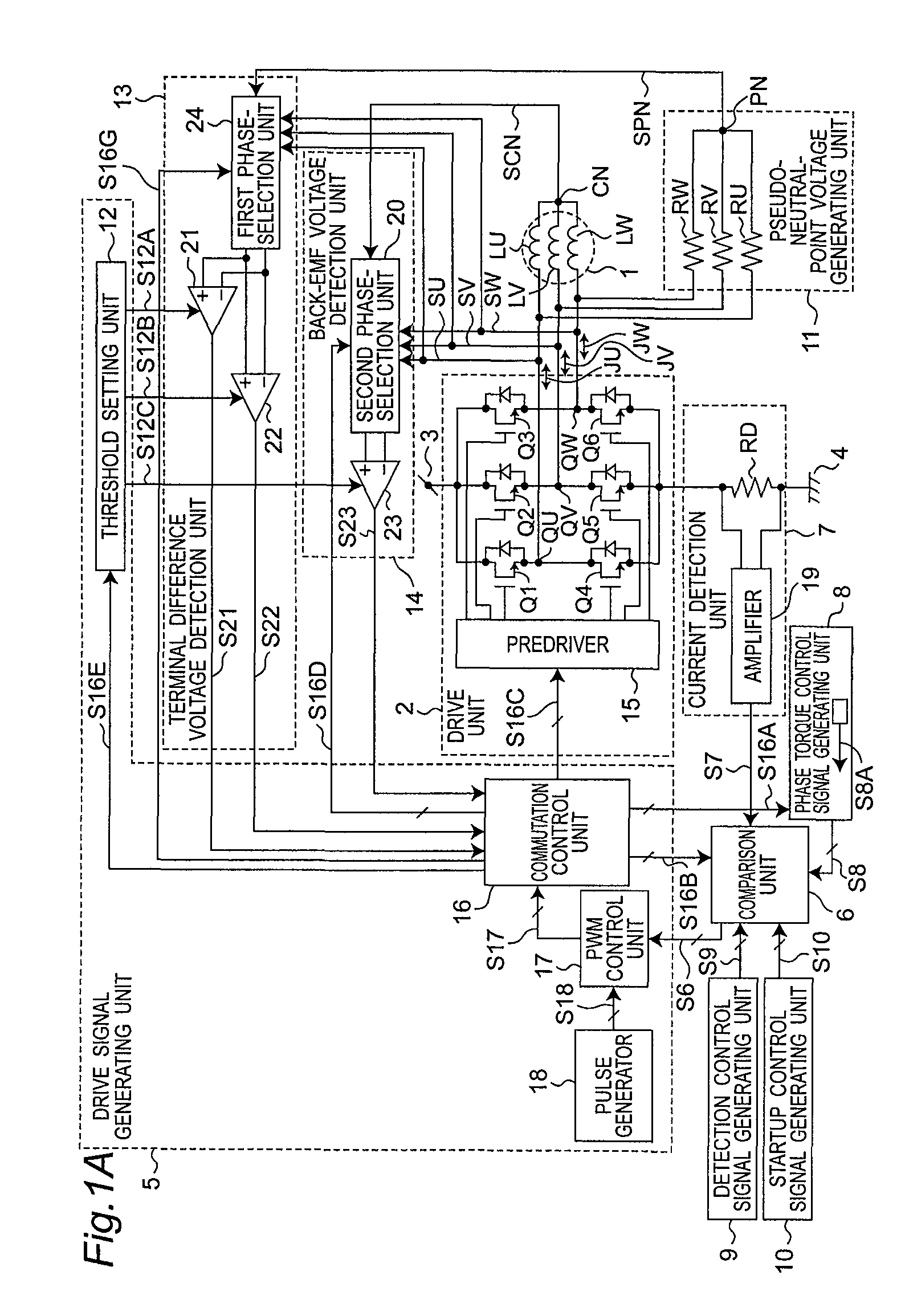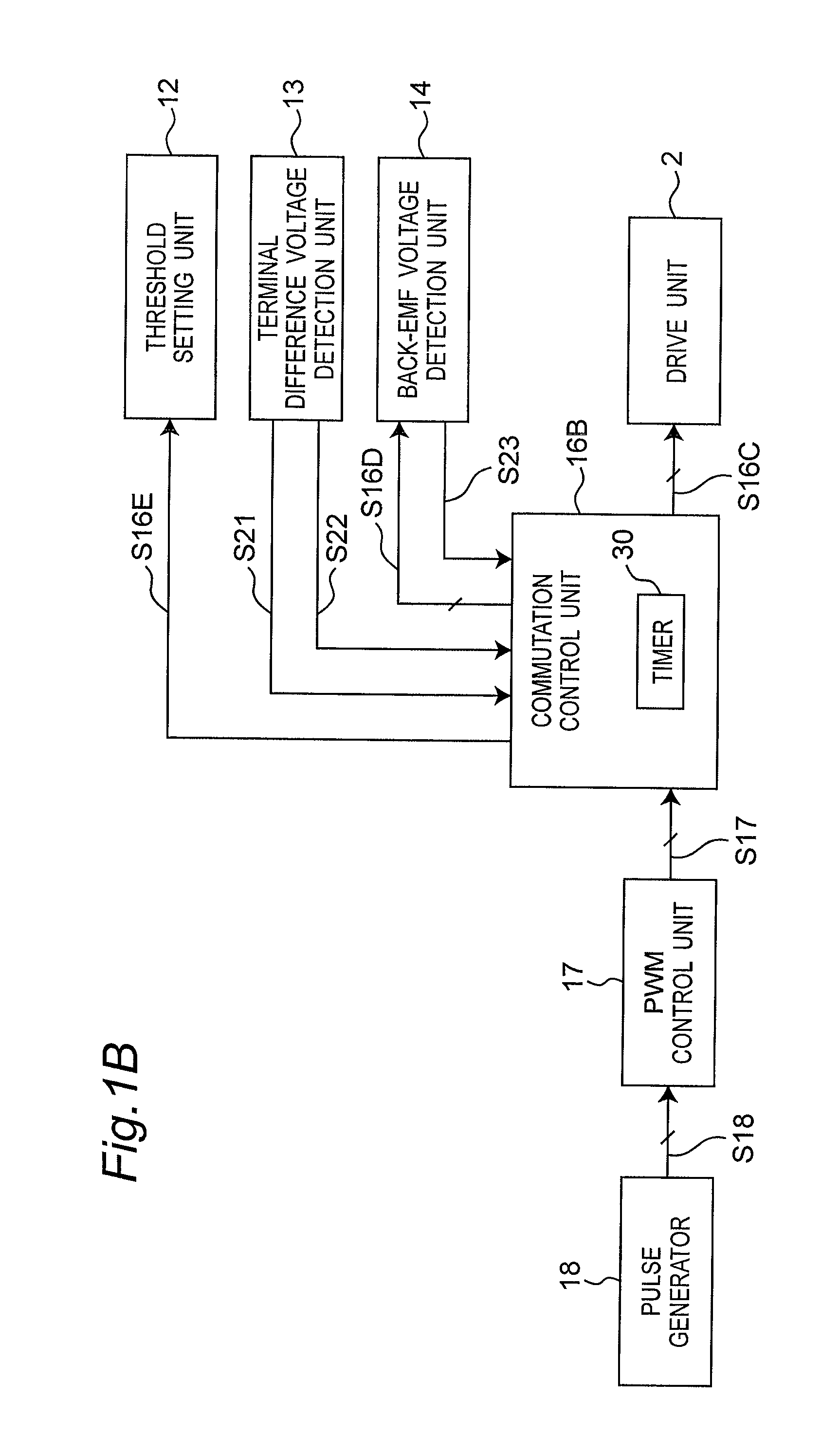Motor drive device and motor drive method
a three-phase brushless, motor drive technology, applied in the direction of motor/generator/converter stopper, electronic commutator, dynamo-electric converter control, etc., can solve the problems of insufficient phase characteristics control, pulse current rise, and difficult to accurately read peak pulse current flow, etc., to achieve the effect of reducing the number of motors, and improving the reliability of terminal difference voltag
- Summary
- Abstract
- Description
- Claims
- Application Information
AI Technical Summary
Benefits of technology
Problems solved by technology
Method used
Image
Examples
embodiment 1
[0068]FIG. 1A is a circuit block diagram of a motor drive device according to a first embodiment of the invention. The motor drive device shown in FIG. 1A has a motor 1, a drive unit 2, a drive signal generating unit 5, a comparison unit 6, a current detection unit 7, a phase torque control signal generating unit 8, a detection control signal generating unit 9, a startup control signal generating unit 10, a pseudo-neutral-point voltage generating unit 11, a terminal difference voltage detection unit 13, and a back-EMF voltage detection unit 14.
[0069]The motor 1 has a three-phase fixed stator and a rotor that rotates around the stator. A three-phase motor 1 is used as the motor in this first embodiment of the invention, but the invention can be applied to any N-phase motor where N is an integer of two or more. The U-phase motor winding LU, V-phase motor winding LV, and W-phase motor winding LW are connected in common at neutral point CN, and the other end of each winding is respectiv...
second embodiment
of the Invention
[0447]This second embodiment is described with reference to the differences from the first embodiment. Other aspects of the arrangement, operation, and effect are the same as in the first embodiment above.
[0448]FIG. 31 is a block diagram showing the circuit arrangement of this second embodiment of the invention. In FIG. 31 the terminal difference voltage detection unit 13 and the back-EMF voltage detection unit 14 shown in FIG. 1A are combined into a single motor voltage detection unit 40. This motor voltage detection unit 40 performs the operations and achieves the effect of the terminal difference voltage detection unit 13 and the back-EMF voltage detection unit 14 in the first embodiment of the invention.
[0449]The commutation control unit 16A generates a phase selection signal S16H denoting the non-energized phase when two phases are energized, and outputs the phase selection signal S16H to a third phase selection unit 41. The U-phase motor terminal voltage SU, V-...
third embodiment
[0462]This third embodiment is described with reference to the differences from the first embodiment. Other aspects of the arrangement, operation, and effect are the same as in the first embodiment above.
[0463]FIG. 33 is a block diagram showing the circuit arrangement of this third embodiment of the invention. This embodiment differs from the second embodiment in that input of the neutral point voltage SCN to the third phase selection unit 41 in the motor voltage detection unit 40 shown in FIG. 31 is eliminated to the fourth phase selection unit 41A shown in FIG. 33.
[0464]The commutation control unit 16A generates a phase selection signal S16H denoting the non-energized phase when two phases are energized, and outputs the phase selection signal S16H to the fourth phase selection unit 41A. The U-phase motor terminal voltage SU, V-phase motor terminal voltage SV, W-phase motor terminal voltage SW, and pseudo-neutral-point voltage SPN are also input to the fourth phase selection unit 4...
PUM
 Login to View More
Login to View More Abstract
Description
Claims
Application Information
 Login to View More
Login to View More - R&D
- Intellectual Property
- Life Sciences
- Materials
- Tech Scout
- Unparalleled Data Quality
- Higher Quality Content
- 60% Fewer Hallucinations
Browse by: Latest US Patents, China's latest patents, Technical Efficacy Thesaurus, Application Domain, Technology Topic, Popular Technical Reports.
© 2025 PatSnap. All rights reserved.Legal|Privacy policy|Modern Slavery Act Transparency Statement|Sitemap|About US| Contact US: help@patsnap.com



